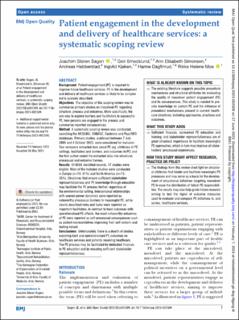| dc.contributor.author | Sagen, Joachim Støren | |
| dc.contributor.author | Smedslund, Geir | |
| dc.contributor.author | Simonsen, Ann Elisabeth | |
| dc.contributor.author | Habberstad, Andreas Hanssønn | |
| dc.contributor.author | Kjeken, Ingvild | |
| dc.contributor.author | Dagfinrud, Hanne | |
| dc.contributor.author | Moe, Rikke Helene | |
| dc.date.accessioned | 2024-02-08T11:10:46Z | |
| dc.date.available | 2024-02-08T11:10:46Z | |
| dc.date.created | 2023-09-05T10:54:33Z | |
| dc.date.issued | 2023 | |
| dc.identifier.citation | BMJ Open Quality. 2023, 12 (2), . | en_US |
| dc.identifier.issn | 2399-6641 | |
| dc.identifier.uri | https://hdl.handle.net/11250/3116359 | |
| dc.description.abstract | Background Patient engagement (PE) is required to
improve future healthcare services. PE in the development
and delivery of healthcare services is likely to be complex
but is scarcely described.
Objectives The objective of this scoping review was to
summarise primary studies on mesolevel PE regarding
structure, process and outcomes. More specifically, the
aim was to explore barriers and facilitators to successful
PE, how persons are engaged in the process and
summarise reported consequences.
Method A systematic scoping review was conducted,
searching the MEDLINE, EMBASE, Cochrane and PsycINFO
databases. Primary studies, published between 7 July
2005 and 4 October 2022, were considered for inclusion.
Two reviewers extracted data about PE (eg, attributes of PE
settings, facilitators and barriers, and outcomes to PE) and
the first author coded the extracted data into structural,
processual and outcome themes.
Results Of 8588 identified records, 37 studies were
eligible. Most of the included studies were conducted
in Europe (n=19; 51%) and North America (n=13;
35%). Structures that ensure sufficient stakeholder
representativeness and PE knowledge through education
may facilitate the PE process further, regardless of
the environmental setting. Interpersonal relationships
with uneven power dynamics were reported as
noteworthy processual barriers to meaningful PE, while
clearly described roles and tasks were reported as
important facilitators. In contrast to hard outcomes with
operationalised PE effects, the most noteworthy outcomes
of PE were reported as soft processual consequences such
as patient representatives improving their self-esteem and
feeling valued.
Conclusions Unfortunately, there is a dearth of studies
exploring hard and operationalised PE outcomes on
healthcare services and patients receiving healthcare.
The PE process may be facilitated by dedicated finances
to PE education and by ensuring sufficient stakeholder
representativeness. | en_US |
| dc.language.iso | eng | en_US |
| dc.rights | Navngivelse 4.0 Internasjonal | * |
| dc.rights.uri | http://creativecommons.org/licenses/by/4.0/deed.no | * |
| dc.title | Patient engagement in the development and delivery of healthcare services: a systematic scoping review | en_US |
| dc.type | Peer reviewed | en_US |
| dc.type | Journal article | en_US |
| dc.description.version | publishedVersion | en_US |
| cristin.ispublished | true | |
| cristin.fulltext | original | |
| cristin.qualitycode | 1 | |
| dc.identifier.doi | 10.1136/bmjoq-2023-002309 | |
| dc.identifier.cristin | 2172428 | |
| dc.source.journal | BMJ Open Quality | en_US |
| dc.source.volume | 12 | en_US |
| dc.source.issue | 2 | en_US |
| dc.source.pagenumber | 11 | en_US |
| dc.relation.project | Norges forskningsråd: 328657 | en_US |

